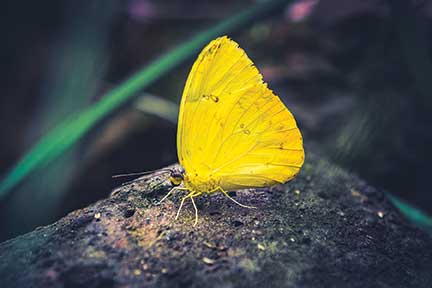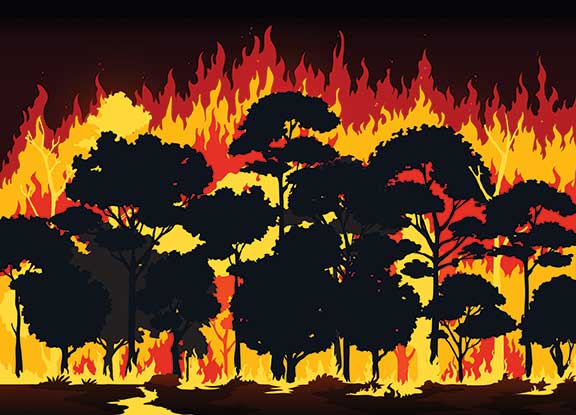Geeta Ramanujam
Imagine…
Close your eyes. Imagine that you are a rock as big as a football. Your home is on a sunny hillside and you can see down into a deep valley with a river gushing far below. You like your home. Sometimes it is very hot here. Can you feel the sunlight warming you?
During the winter, you get worried about the ice that freezes in the crack on top of you. This crack grows bigger each year because the ice pushes hard on the sides of the crack.
One spring it is very wet, wetter than you can ever remember. Rain pours down in little streams rushing down the hillside. Feel the water flowing over you and into the soft mud below.
Suddenly you feel the Earth rumbling and shaking. You look up and a large wall of mud rushes down and sweeps you up. You begin to roll down, down, down into the valley. Ow! You hit another rock and split along the crack that has been growing every year. Now you are two halves rolling down the hill.
Splash! You land in the river. For days and days, you are pushed by the swift, strong waters. Rolling and bumping along you are breaking into gravel and sand. Finally, the river enters the ocean and your many pieces settle onto a large, flat area along with millions of pieces of sand, gravel, and silt.
Some pieces settle on top of you and you are getting squished. You yell out, “Stop pushing!” but more and more weight presses down. Your pieces get pushed and stuck together with other pieces. You are now hardening and becoming a sedimentary rock.
The pressure grows and you begin to get warmer and warmer. You change colour and form into many hard crystals. Now you’re a metamorphic rock.
You keep getting pushed further down. It is hot. It is boiling hot! Everything begins to melt and you are part of a hot mass of melted rock called magma deep underground. It seems like forever that you are part of this big melted sea of rock. Will you ever see the sun again? You want to be back on your hillside feeling the hot sun, and cool wind, and rain.

Wait, you’re being pushed up and the Earth is shaking and rumbling again. You are rising higher and higher. Fire, ash, dust, and steam surround you and with a loud explosion, you burst out of the top of a volcano. Red, hot lava is all around. You are a scalding, steamy piece of lava shooting through the air when, suddenly, you land on a high point of volcano away from the hot flow of lava below.
Slowly the volcano begins to settle down and the lava cools and hardens. You are now a cold, grey igneous rock on top of a high volcano looking down at a river flowing far below. When the dark ashes blow away and the sky clears, the sun comes out and warms you, high up on the volcano – your new home.
We all experience stories. I have been travelling and telling stories for the past 40 years and I have felt my stories as I touched them and smelt them. Yes! I have noticed the weather change the Earth’s colours, the missing trees replaced by buildings and structures, and feel their pain in my being. As I visit the same places again and again like the Himalayas or the mountains in South India I know that those rare birds have all flown away, that the butterflies have vanished.

After a recent training session, I was returning from the mountains. The shadows lengthened as I left the quiet valley of the Himalayas in a taxi. There was heavy traffic and the taxi halted. I peered out the window and noticed a butterfly gracefully seated upon a round brown rock. I thought – butterflies have such a short and sweet life; it is so colourful, seated upon a rock that has perhaps been here since the Earth evolved. There is so much harmony between the living and non-living forms of nature. The essence of the living butterfly was its colour, which added a touch of beauty to that rock.
In that expression of nature, I discovered a space that was vast. There was also a lonely and solitary tree that stood alone on a hill. The tree was huge and the grass beneath so short, yet they co-existed.
My eyes went back to the butterfly. I think butterflies are the most beautiful creatures. Most butterflies, like this one, I know, have large wings and are brightly coloured. Looking at the rock on which the butterfly was resting, I remembered the two most important rocks that made up the Earth’s surface – granite and basalt. Granite is found almost all over Bengaluru, especially near Ramnagaram. It would be a great place for rock climbing, don’t you think? How the Earth hides its story in these rocks!
I remembered an old Native American story of the rock that told a tale to a boy named Naho. Native Americans believe that Grandfather Rock was the first storyteller in the world. So, each day the rock told Naho a story, and then one day, he said, “I have told you all my stories. You will pass these stories on to your children and other stories will be added to them as the years pass.” Thus it was that stories came into the world.
As I came out of my reverie, I wondered what would happen if this butterfly died on this rock. It will be caught in the sediment of this rock, leaving its imprint behind. It might even become a fossil later on. People may try to find an explanation for this butterfly and dig out facts about it ages later. This rock is a witness to the constant changes in this world. Each rock has a world within it. The rock gave me a sense of strength.
My taxi started again with a jolt, I saw the butterfly flit away. It flew to a nearby forest. As the taxi began to descend I witnessed a forest fire. This was the first time I was experiencing something like this at such close quarters. The smoke filled the road and the driver was unable to steer the taxi through the thick smoke. Trees bent and fell and I had to reach Kadgodam station for my train. I was actually witnessing what people were discussing at my training – CLIMATE CHANGE AND ITS EFFECTS.
I reached home and narrated what I had just experienced to my daughter. She pulled out a book on butterflies and we found out that what I saw on the rock was an Indian leaf butterfly. It was a beautiful yellow butterfly that matched the brown rock so well. Noticing that I was sad my daughter asked me, “Are you sad that the butterfly flew away from the rock or troubled by the forest fire?” I smiled and told her that things pass, and so do the best and worst moments of life.

I wrote my diary that day…
What is the butterfly effect?
In China a butterfly flaps its wings, leading to unpredictable changes in US weather a few days later.
The epic 3,000-mile monarch butterfly migration may become a thing of the past. Each fall, monarchs travel from their summer homes in the northern US and Canada to winter habitats in California and Mexico.
Imagine that you lived in a country, where unknown to you was a giant cauldron beneath and someone had just lit the wood piled under that cauldron.
At first you might say, “Does it seem hotter?”After a while, the plants might start to wilt, wildlife begin to relocate or even die, the days might seem warmer and there maybe fewer cool days, and you are saying, “You know, it does seem hotter.”
Pretty soon the consequences get more disastrous and widespread, and eventually it is hard to continue living in the drastically changed climate of your world.
The greatest danger to humanity from climate change is the extinction of life on this planet in a short period of time. An event such as this would make it near impossible for humans to survive. Think about what would happen if plants became extinct, including the ones we cultivate. And herd animals. And bees and other plant pollinators. Every year our country witnesses forest fires, floods, droughts affecting irrigation, resulting in a huge loss to the economy, as well as to poor farmers (many of whom surrender and commit suicide).
In the recent floods in Assam, millions of people have been displaced and thousands have died. If we include the after effects, the losses would be many times higher. All this happened within a year of the landslide in Uttarakhand, where also tens of thousands died. Even as I write this a massive cyclone is being alerted in the state of Andhra Pradesh.
You still want to question climate change? We must accept our inability to confront and mould nature as per our demands and wishes.
The author is an internationally acclaimed storyteller, author, trainer and academician. She founded Kathalaya’s International Academy of Storytelling in 1998 which offers certified courses for adults in storytelling. Geeta has trained over 94,491 people in the art and has won many accolades for storytelling. She has recently published a book, Tales from the World. She can be reached at geetastory56@gmail.com or kathalaya@gmail.com.
